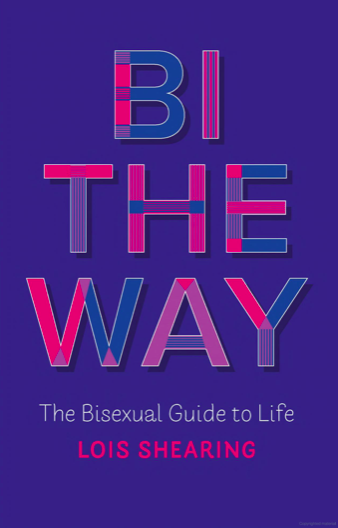Reviewed by Ellyn Ruthstrom
Do you want to read about the major questions that come up in bi+ life and want a way to pull all the answers together in an accessible and interesting book? Of course you do, and Lois Shearing’s book, Bi the Way, is a wonderful place to start. Grab a cuppa and cuddle into your favorite chair this winter for a few hours, and you will get a mixture of bi history, bi issues, and bi strategies. You’ll also get a sprinkling of diverse bi voices throughout, as Shearing weaves others’ experiences and opinions throughout the chapters.
If you are a part of the bi+ community for long enough, you end up living through a media wave of “the new sexuality” or “everyone is suddenly bi.” Every ten years or so, bisexuality is rediscovered by some major magazine and everyone gets enlightened all over again. But just like Columbus and his “discovery,” we were already here, thank you very much, and we’ve been breaking down barriers for decades. Bi the Way gives you a good sense of where the early organized movement started and points out some of the ground-breaking bicons like Brenda Howard, Donny the Punk, ABilly Jones, and Lani Ka’ahumanu who organized significant events and organizations in the early days of the movement. (Though I do need to point out that the book incorrectly identifies BiNet USA as being the oldest bi organization in the world. The Bisexual Resource Center, originally the East Coast Bisexual Network (ECBN) was founded in 1985, before BiNet USA in 1990.)
There are some great chapters on coming out, biphobia and bi erasure, and the ever-popular one on dating while bi. These are areas that are essential to understanding the bi life, and Shearing does a great job with dissecting the issues and providing some personal advice as well as the experiences of many others to serve as a support system to make it through the sometimes bumpy journey of a modern bi. Her analysis of bi erasure in the media is spot-on and will make your blood boil.
Something I really appreciated in the book was the acknowledgement of the way bi+ folks refuse to be pinned down, and while it can be what is frustrating about our community (as a bi+ community organizer, I can attest to this) it is also an essential part of the bi+ worldview. Bi+ folks accept that life is fluid, identity is fluid, human beings are fluid. Shearing notes that this has long been part of the movement’s ethos, citing Paula Rust’s work in 1995, Bisexuality and the Challenge to Lesbian Politics, “Thus, bisexuality and bisexuals resist being co-opted into categorial thinking and in doing so, remain a challenge to dichotomous sexuality.”
Chapter 9 is essential reading for anyone who has asked the question “What issues do bi people face?” Shearing shares the research and experiences of the bi+ community with physical and mental health disparities, addiction, poverty, homelessness, employment discrimination, asylum seeking, and intimate partner violence. The organized bi+ community has been building a case for attention to our community needs over the last ten years with the research that Shearing includes here. Keep this chapter at the ready as testimony for the urgent needs of our community!
Shearing points out in several parts of the book that, despite these multiple indicators, that bi+ individuals experience the challenges mentioned at a higher rate than gay and lesbian individuals, there is a lack of funding and therefore lack of attention to the bisexual community by the LGBTQ+ mothership. So often an individual or a small group of people start a bi+ group and just keep it going by sheer will and potlucks. It’s a space for these bi+ folks to feel free to be themselves and to be validated and seen. Imagine if the larger LGBTQ+ organizations actually took it upon themselves to welcome those groups and help them access resources and thrive?
One of the things you hear the most when you get bi+ folks together is the ongoing need for community connections, so I’m sure the most helpful reference section for a lot of people will be the last chapter on bi community. Though I would have appreciated URLs or Facebook groups to be noted so you know where to look for the larger groups online. (The resources are more focused on European organizations as it was published in England, so I would always point folks toward BiResource.org for those based in the U.S.)
Shearing’s experience within the London bi+ community has given her an inside view of what bi organizers are up against, and she is not accepting second-class citizenship for herself or our community. She writes, “Bi people have been part of the struggle for sexual equality since the beginning. Bi people’s experiences and issues deserve space and attention. What anyone thinks of that beyond ‘how can we work together to achieve our collective liberation’ is no concern of mine. Our existence has been debated too much for too long for any other stance to be possible. I wish the energy upon you, too, dearest reader.”
Amen! Our community is continually forced to prove ourselves worthy of attention and worthy of inclusion within the larger LGBTQ+ movement. I love Shearing’s attitude to boost our self-worth, self-confidence, and pride in our identity and in the work our community has accomplished.
Ellyn Ruthstrom has been living the bi life for several decades and believes herding cats is easier than organizing bisexuals.

